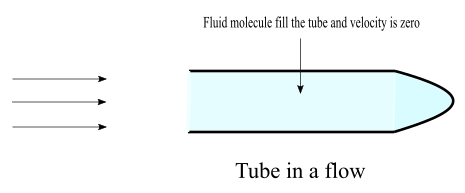What are stagnation pressure and stagnation temperature?
What are stagnation pressure and stagnation temperature?
Pressure is defined as force per unit area. In fluid pressure on a surface is the normal force acting per unit area due to time rate of change of momentum of the gas molecules which is impacting the surface.
The pressure due to the pure random motion of the molecules of the gas is the static pressure. Whenever a body is in a flow, the fluid will get an obstruction at the surface of the body and the velocity of the gas molecule will be zero. If a body is a tube with one end closed, the fluid molecules will fill the tube and its velocity will be zero, that the fluid will stagnate.
At the opening of the tube the fluid molecules sees obstruction. Therefore upcoming fluid molecules slows down and reduces to zero velocity. Any point in a fluid flow where flow velocity is zero is called the stagnation point. As velocity is decreased so pressure is increased. Therefore, pressure at stagnation point is larger than the static pressure.
The pressure at the stagnation point is called the stagnation pressure or total pressure.
Therefore, there are two types of pressure in a fluid flow, static pressure and total or stagnation pressure. Static pressure is the pressure which is felt when a fluid has a velocity and stagnation pressure is the pressure that is felt when flow velocity is reduced to zero.
If a flow is isentropic in between two points then the total pressure is constant at that points. An isentropic process is a process in which entropy remains constant. An isentropic process is both reversible and adiabatic.
The temperature of a gas is directly proportional to the average kinetic energy of the gas molecules. Therefore, a gas which has a high temperature, the molecules are moving randomly at a very high speed. A gas in low-temperature, there is a slow random motion of the molecules as compared to the high temperature gas.
The temperature of a fluid element when it is bought to rest adiabatically is called the total temperature. Stagnation temperature is the temperature when a moving flow is isentropically brought to rest. At the stagnation point total temperature and stagnation temperature have the same value.




